Sustainability science: living within planetary boundaries - IRD
←
→
Page content transcription
If your browser does not render page correctly, please read the page content below
ns
olutio N°1 - 2021
and S
ce
Sc
ilit
y, ien
inab
Susta
Sustainability science:
living within planetary boundaries
Since its creation, IRD has been taking action for development and seeking solutions for the world’s population.
It is this little word, “for”, that unites all the researchers at IRD. Even though the issues on the table are globalised
and interconnected, the time has come to share the unique IRD approach, going even further in terms of
collaboration between countries and disciplines, and reconciling global and local perspectives more effectively.
This is the aim for IRD's new show, Hello World, Hello
Solutions, which launched on 21 April 2021. It is open
to all, featuring internationally-renowned researchers
and local voices that receive too little coverage. The
first show included link-ups with Mali, Senegal and
Chad. A farmer from the Sahel region shared his story,
describing seeing his livestock emaciated. This intense
moment demonstrated the gaps in perception
between North and South and, if anyone was not yet
convinced, the urgency of working together, adapting
theoretical models to local challenges, and simply
doing science differently.
With Hello World, Hello Solutions, the IRD aims to
demonstrate that it is possible to overcome the spe-
cific dynamics of each scientific discipline or laborato-
ry, by focusing on more global problems. And this can
be pursued via a collaborative approach, to co-create
solutions with the local population.
Two founding notions serve as our compass: planetary boundaries and the doughnut
model.
Nowadays, we know how to produce information about the
planet's functioning and measure the impact of human
Key words activities. For the future, we want to understand the causes of
Anthropocene | Essential the changes and the related dynamics.
needs | Resource circularity (Olivier Dangles, IRD, Deputy Scientific Director)
| Local level | Dynamic
balances | Planetary
boundaries | Social
boundaries | Reflexivity | A show from IRD, dedicated to the science of solutions
Resilience | Doughnut model Overcoming the specific dynamics of each discipline
Watch and rewatch the show
https://www.ird.fr/helloworld Creating in collaboration with the local populationWhen will we truly understand that the planet has boundaries?
Four boundaries have already been exceeded: climate change, biodiversity loss, disruption of the nitrogen cycle and
disruption of the phosphorus cycle. This was the tragic observation made by Johan Rockström, internationally
renowned ecologist. The planetary ecosystem has become unstable and vulnerable. At present, it is at a critical tipping
point. There are only a few decades left to change things. This awareness of the boundaries and their interactions
opens up fascinating potential avenues for research and innovation.
Johan Rockström's concept of nine “planetary
The planetary ecosystem cannot remain
boundaries” and the risks caused by exceeding them
stable with today’s practices and
has become a reference in sustainability science. It
requires a new kind of thinking about the development pressure from societies.
of societies. (Johan Rockström, Potsdam Institute for Climate
Impact Research)
To stay within the planet's boundaries,
we have to reach across the borders between disciplines
But how? With traditional economic models based only on GDP growth, it is not possible to maintain this dynamic
balance. There are partial answers to be found in the approaches of the UN's 17 Sustainable Development Goals. Kate
Raworth's doughnut model presents an alternative to the growth indicators that are used at present, one that's fair,
equitable, distributive and circular. The principle is to allow humanity's essential needs to be satisfied, while not
exceeding the planet's boundaries.
The gaps between scientific data and the perception of local populations demonstrate the limits of one-sided,
compartmentalised scientific research. The solution requires better collaboration to create knowledge, bringing
environmental and social sciences together.
A point of vulnerability has been encountered, as
attested by the emergence of new risks and the study of It is not only a question of thinking about
glacial cycles. It is a generational challenge that requires what already exists, but rather, proposing
greater cooperation. According to Kate Raworth, no-one pathways for development.
really knows how to transform the economy sustainably. (Kate Raworth, economist – Senior Associate at Oxford
Countries from North and South must take up this University's Environmental Change Institute and
challenge by working together, which also opens up Professor of Practice at Amsterdam University of
avenues for interesting interdisciplinary research. Applied Sciences)
Donuts nationaux
Donuts nationaux
Donutsgoodlife.leeds.ac.uk
goodlife.leeds.ac.uk nationaux
from one Chine Chine Canada Canada
goodlife.leeds.ac.uk
Malawi
Examples of variations Malawi country to another Chine Malawi Canada
Certain countries have not quite met their essential needs and
others have exceeded the planetary boundaries.
• In Malawi • In China • In Canada
In red, many Red still in the centre All fundamental needs
essential needs are and five planetary are met, but six
not met. The boundaries planetary boundaries
ecological ceiling has exceeded. have been far
not been exceeded. $1,000 pc $1,000 pc $17,200pc $17,200pc $47,600 pc $47,600 pc
exceeded.
$1,000 pc $17,200pc $47,600 pcWhat about finally listening to voices from the South?
Mame-Penda Ba, a charismatic political scientist, notes that in these two models, cultural specificities and
intergenerational aspects are taken into consideration very little. In the final part of the first Hello World, Hello
Solutions, researcher and artist Christian Seignobos's eloquent contribution as a recognised expert on the Lake Chad
crisis also questioned the dialogue between scientists, with the aim of breathing new life into it. Geographer Hadiza
Kiari-Fougou described the issue for this region in concrete terms. With climatologist Florence Sylvestre explaining
the attempted solutions to reduce the vulnerability of the population to these hygrometric variations, which remain
far too unpredictable, everything seems to point to the same conclusion. All sciences, local stakeholders and available
resources must be brought together urgently to manage this critical territory sustainably.
These examples (Sahel, Chad, etc.) analysed by Mame-Penda Ba and Hadiza Kiari-Fougou, as well as the two IRD
researchers, Laurent Vidal and Florent Sylvestre, show that it is necessary to think on a local scale. Lastly, sustainable
solutions must be created without dogmatism, drawing on a combination of scientific rigour, practices, experience
and local perspectives.
os
These populations are producing
nob
eig
Chr
istia
nS solutions, they are not waiting for
RD_
©I
generalised, dogmatic and authoritarian
responses to come from elsewhere, they
are forcing us to look at the diversity of
knowledge. What would be interesting
for us would be to share these solutions
better in a North-South dialogue, feeding
an interdisciplinary approach, going
beyond the sole dialogue between hard
and soft sciences and drawing on local
knowledge.
(Mame-Penda Ba, political scientist – Research
Professor at Université Gaston Berger in Saint-Louis
and director of the Laboratoire d’Analyse des
Sociétés et Pouvoirs d’Afrique et Diasporas
(LASPAD))
Solutions for mitigating the population’s dependence on fluctuating
water levels
Report: the Lake Chad situation
The first thing to note is that the lake's area has varied over the years. In the 1950-1960s, it was a single stretch of
water of 25,000 km2. During the two decades of extreme drought that followed, the lake split into two basins. Then,
fresh rains refilled the lake, which nowadays stretches over 1,400 km2. Since the late 1990s, human activity in this area
and national political dynamics have only amplified the lake's fluctuations. Periods of drought and flood mark this
area, which is extremely important for Chad and a large number of neighbouring countries from Sudan to Congo,
which are supplied by the lake's tributaries. The lake's catchment basin covers nearly 2.5 million km2, or nearly 8% of
the African continent. Boko Haram's presence in the north of the basin has stopped all activity there since 2014.
The challenge
The challenge is to meet the needs of 50 million habitants. The extremely unpredictable fluctuations disrupt the envi-
ronmental ecosystem and force populations to migrate to other regions that might be able to offer them some sub-
sistence activities.Solutions
Providing reliable meteorological and hydrological forecasts to the local population.
In this specific case, where conditions are extreme, one solution in my eyes would be to set a
hydrometric minimum that allows life in general to continue. But a "down-top” approach
would be needed for this, considering the planetary boundaries framework, key elements
and general common aspects, as together they determine and create a viable/beneficial
system.
(Laurent Vidal, IRD Representative in Mali)
Difficulties to be overcome
Defining solutions that the population accepts is complex. Specifically, there is a certain mistrust of governmental
measures due to a relationship that historically has been conflict-ridden, dating back to the period of great drought in
the 1970s. Another difficulty is the local population’s lack of information regarding the various issues connected to the
lake's fluctuations, political issues in particular. Local public authorities also have trouble understanding the problem
as multidimensional and transdisciplinary (simultaneously geographical, biophysical, sociological, political, etc.) This
comes from the fact that the scientific disciplines are still too compartmentalised and do not exchange with each
other. Another essential dialogue is lacking, between the public authorities and the population directly concerned.
The solutions that are needed can only be created in a safe local context.
(Florence Sylvestre, IRD Correspondent in Chad)
Viva sustainability science!
Sustainability science aims to provide concrete solutions to complex, interconnected problems.
ugo
u It encourages more collaboration between disciplines, more participation and above all, greater
i Fo
adiz
a Kiar foundation in the reality of life for the population. It may seem obvious, but this way of
H
RD_ doing things is still marginal. There is a lot of work yet to be done. Hello World, Hello
©I
Solutions is opening the way and aims to demonstrate this essential interaction
between concepts, tools, and realities on the ground, between researchers, local
authorities and the population.
The stakeholders involved in these questions fully subscribe to this twofold analysis
model (planetary boundaries/social floor). They have identified the same methods for
action: the need to create more interchange between North and South, go beyond
theoretical debates, encourage more reflexivity between disciplines and between
environmental and social sciences, permanent interaction between concepts, tools and
realities on the ground, between researchers, local authorities and the population.
Understand
Notes from:
https://www.ird.fr/hello-world-1-vivre-
IRD June 2021 © Texte, Neotopics Catherine Malaval - Graphic design, Sabrina Toscano
dans-les-limites-planetaires
Doughnut Economics Action Lab platform:
https://doughnuteconomics.org/
Planetary boundaries:
https://www.stockholmresilience.org/
ePop network
https://epop.network/
Hadiza Florence Mame-Penda Johan Kate Laurent
Kiari-Fougou Sylvestre Ba Rockström Raworth Vidal
Featured on the 1 show
stYou can also read























































